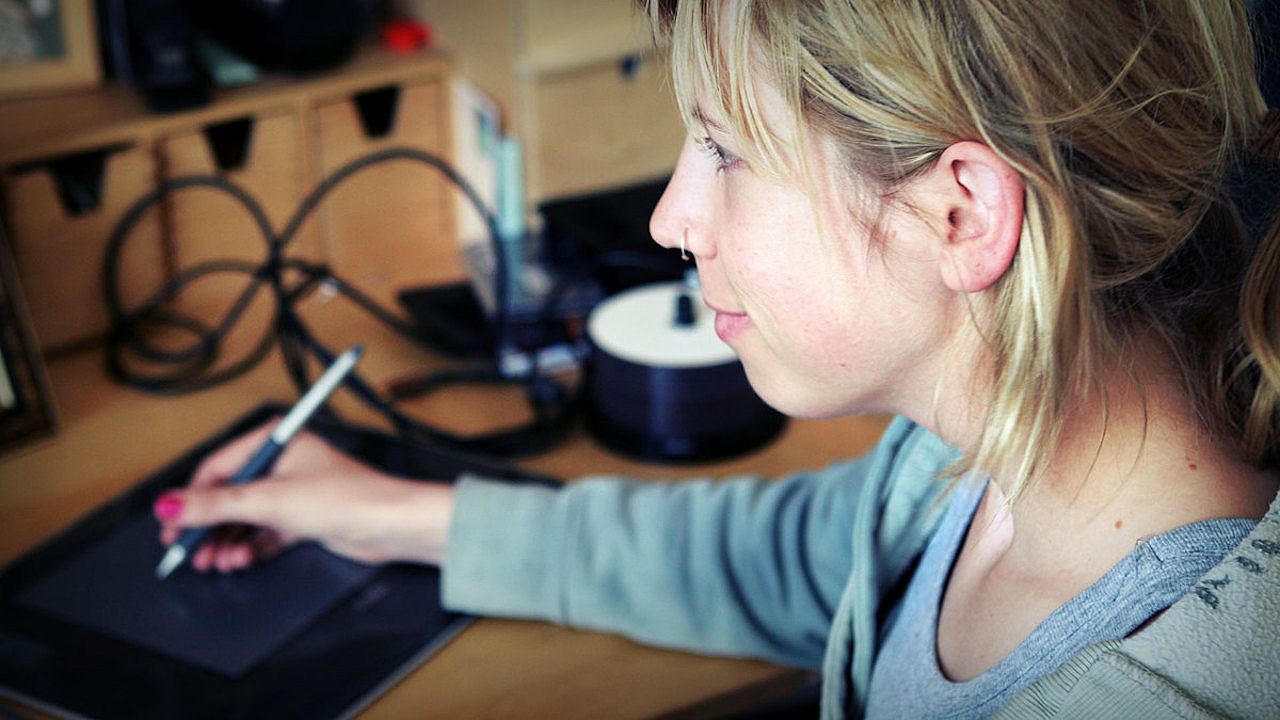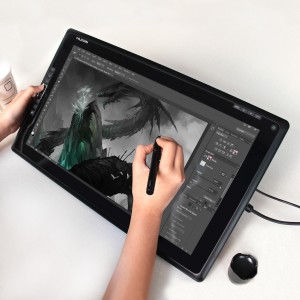Big Idea: Digital Tablets
Jun 9th 2016

📢 Post updated August 2024!
Tablet vs Mouse
New digital artists often ask the question, "Why get a tablet when I have a mouse?" Perhaps tablets give the impression of being a luxury rather than a necessity. And depending on your interests, a tablet can be a luxury or a necessity.
Who is the tablet for?
Tablets are most useful for certain disciplines: Digital painting, 3D modeling, 3D sculpting, and texture painting are the obvious candidates for a tablet. In fact, for those I would say a tablet is necessary. For other disciplines like rigging, animation, dynamics, and compositing, a digital tablet isn't as much of a necessity. Having said that, I've known riggers and animators who use a tablet exclusively. I've also known modelers who use a mouse exclusively. So we're not really talking about a right or wrong here. A tablet can be for anyone who wants to interface with the computer in a more natural, pencil-and-paper kind of way. Even though there's subjectivity involved in choosing a tablet or mouse, there are some objective benefits of a tablet over a mouse:
- Pressure Sensitivity: Tablets offer the ability to alter input based on the pressure of the pen against the tablet surface. This functionality has tremendous benefit when blending gradients in a painting or carving in digital clay; something a mouse cannot do.
- Tilt Sensitivity: Some tablets recognize the tilt of your pen to enable additional functionality that can't be emulated by a mouse. Think of when an sketch artist tilts a pencil to use the length of the tip for shading.
- Carpal Tunnel Prevention: While tablets aren't a cure for carpal tunnel, it does provide a more natural movement than a mouse. But the task variety of switching between keyboard, mouse, and tablet is beneficial for preventing carpal tunnel syndrome.
Kinds of Tablets
Of course there's a variety of choices in the world of digital tablets, as with anything. Some choices are simpler and budget-friendly while others offer the fanciest features and immersive interaction to make for the best artistic experience. Let's take a look at 3 tablet "classes".
CLASS 1: Tablet
"Intuos" by Wacom
This is the baseline class featuring a standalone tablet that offers no-look pencil-to-paper interaction. By "no-look", I mean the hand-eye coordination is like that of a mouse where you're looking at a computer monitor to see the result of your hand movement while your hand is actually moving out of sight. This kind of coordination can take some getting used to at first. But this class is the most affordable. The "Intuos" line fro Wacom is one of the most popular standalone tablets.
This is a good entry-level tablet class for digital artists who want the baseline benefits of a tablet. They're great for 3D modelers and sculptors.
CLASS 2: Tablet + Display
"GT-185" by Huion
This class eliminates the hand-eye coordination problem by making the tablet surface a computer monitor itself. So it's like drawing "on" a digital canvas, making for a much more natural interactive experience for digital artistry. Some consider it to be a negative of this approach that your arm covers a portion of the screen as you work - Traditional drawing and painting have the same problem. Brings back memories of graphite palm from my school years...The "Cintiq" is one of the most popular display tablets.
These are expensive tablets that are great for committed/professional digital painters and sculptors.
CLASS 3: Tablet + Display + PC
"Surface Pro" by Microsoft
This class offers the full package of being a tablet and display and computer. It's like having a digital drawing notebook in your backpack anywhere you go. As you can imagine, tablets like this are expensive. But they're growing in popularity thanks to an expanded manufacturer pool including Apple and Microsoft.
Brands
There are many companies offering tablets, but here's a few key players.
- Wacom - Leading tablet manufacturer offering all 3 classes. They've been around the longest, offering decades of reliable hardware and software, and tend to be the most expensive in each category.
- Huion - Quality manufacturer offering all 3 classes.
- XP Pen - Budget tablet manufacturer of class 1 and 2 tablets with an Android-based option for class 3.
- Gaomon - Budget tablet manufacturer of class 1 and 2 tablets with an Android-based option for class 3.
- Apple - iPad Pros qualifies as a class 3 tablet with a highly-praised user experience. However it should be noted that the iPad Pro runs iOS and AppStore apps instead of a desktop OS, meaning Blender is currently unavailable.
- Microsoft - Not to be outdone by the competition, Microsoft too has entered the tablet market with their class 3 Surface Pro.
What We Use
"I currently have a refurbished Intuos Pen & Touch model from Wacom. Before, I used a Bamboo Fun ($80 back in the day) that lasted 8 years and never stopped working. Moral of the history: Wacom is a quality brand and I get along fine with class 1 tablets." - Kent Trammell"I've used three tablets, all Wacom brand. I started with an old hand-me-down Intuos 1 or 2 (I don't remember which). After a few years of fiddling with it I upgraded to a Intuos 4 Medium, which is the tablet I still use today. For a while I added a 13in Cintiq but ended up selling it as I was no longer sculpting every day and preferred the ease of which the Intuos 4 could be slipped into my backpack." - Jonathan Williamson"I really enjoy using my Medium Intuos Pro when I'm working at my desk, but I've been using my Surface Pro a lot more because it's so portable. It has a solid drawing experience and can run full desktop apps like Photoshop and Blender, which makes it much more useful than a normal tablet or a normal laptop." -Jonathan Lampel"While I was in college I owned a Bamboo and since then have owned a Wacom Intuos 3 and 4, a Cintiq 13HD, and most recently a 22 Cintiq Touch. Based on my experience, I believe that all tablets function in a very similar fashion it just comes down to personal preferences. These can include the grip feel of the pen, the surface of the tablet (glossy or matte), the buttons available on the tablet, or even the most obvious preference: the size. I've found that working with a larger size feels closer to a traditional experience and using a cintiq has proved beneficial in terms of working with more precision and control, especially with edges or line work. The touch features feel natural and while they don't always respond at first swipe, I've found myself using the zoom in and out feature a lot during the duration of my paintings. If you can test one out before buying one, a large comic convention is bound to have a Wacom station or a booth with cintiqs on display to use. So before rushing into one, I would recommend testing out a few of them first to find the right fit for you!" - Tim Von Rueden (vonn)




The genius tablet I use is battery-free.
I had a Bamboo Wacom tablet for around four years myself. Eventually the back of the pen kept popping off, and the wire had to be replaced which resulted in a crack in the frame, but it still works quite well. The small size of it really got to me though, I've always had a bad habit of drawing too big for a piece of paper so that table felt extremely constricting. I switched to a 9x12" Genius Pensketch tablet, which unlike the Wacom didn't work with my OS out of the box. I ended up having to manually upgrade my entire OS from Linux Mint 17 (kernel version 2) to a still somewhat experimental Linux Mint 18 (kernel version 4) to get it to work, but now that it does I'm really glad I made the change. The larger tablet is more comfortable on my lap, I can use full arm movements instead of wrist and finger movements, and the texture of the Pensketch feels more like paper to me than the Bamboo did.
All in all though, I would really like to upgrade to a display tablet, at least. Even after all this time drawing on one surface and looking at another still doesn't feel completely natural.
i used a Wacom Graphire 4 for years, until i saved enough to get an Intuos Pro Touch. excellent kit, though the nib wear can be a touchy subject [just look at the 80-page threads on the Wacom site...]
one thing to mention about Wacom is their pens are the only ones that are battery-free, so bear in mind if you get another brand you risk losing time/functionality as your battery runs down and you have to recharge.
Hello All!
Interesting subject. For my own I work since many years with a graphic tablet. My first one was a small one, and I do not remember it's name. But since I've tasted working with a tablet I can't imagine working without now. Now I got a Wacom Intuos4
and I used it for each of my software. Stylus, Touchring, Express keys, sensitivity and so on, are all advantages that help the workflow. I work on Blender, Photoshop, Illustrator, C4d for the main soft and it's a real comfort.
It would be great that one day we can use all the possibilities offered by wacom tablet on Blender. Imagine using the touchring to control the size of the brush when you sculpt (like in photoshop)....
Have a nice day.
I have been using mouse my whole life, so when I first got my bamboo pen&touch I couldn't even make a decent brush stroke...I had to sync eye and hand and for people like me that attended the art school, where everything you sketch is on paper, was difficult to nail. But! I must say that after few years using the tablet, I finally found my own pace. I mostly use it for texturing or sculpting details..and I could never do a clean work without my bamboo..also sketching the model sheet is fundamental if you are a 3D modeler....get one if you don't have it ;)
curious to know if anyone has experience with HUION tablets? I'm using a medium Intuos for sculpting on Ubuntu and it works really well for me. I'd be tempted by a cheaper alternative to Wacom if I ever wanted to move to level 2 though.
This provides some good insight. I've got a cintiq but its screen is to small. I think I'm going to try a larger tablet without a display to see if that suits me better.
I'd love to see an article like this on the best computer set-up for blender. I have a recent iMac but I suspect I could get more horsepower with another OS and cheaper hardware.
Do you know anyone with a coast22? I was looking at that myself but haven't seen much about it review wise.
My tablet has touch functionality and it's surprisingly refined in terms of ignoring my resting palm compared to the stylus. Also the touch feature can be turned off by a physical switch.
Touch sensitivity sounds like a drawback for a digital stylus tablet. How do you rest your hand on the tablet while using a stylus, if it is detecting your hand and constantly misreading it as action commands?
The really old 1990's Wacom tablets exclusively detected the stylus and had no touch sensitivity whatsoever. They sound like they'd work better for someone who rests their hand on the page while drawing with the stylus.
Your example image of the Microsoft Surface with the person's hand hovering above the screen looks highly unnatural, strenuous, and possibly tiring or painful for long-term work.